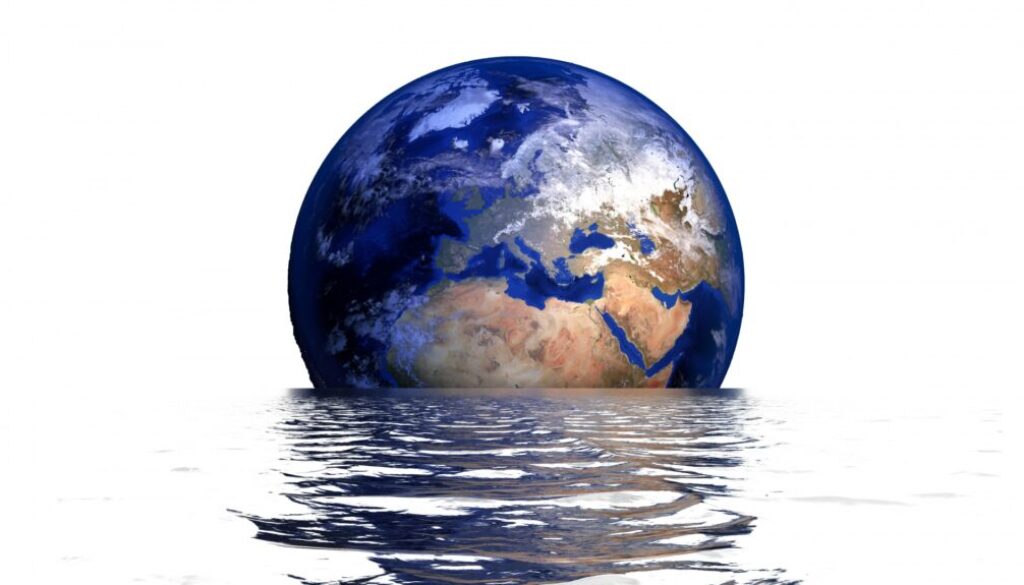Dire Straits with a Changing Climate
By Aparna Mele MD
“Preserve and cherish the pale blue dot, the only home we’ve ever known.” — Carl Sagan
Global climate change is not a future problem. It’s happening! Global average temperature has increased about 1.8°F from 1901 to 2016, created by increased human emissions of heat-trapping greenhouse gases. Changes of just one or two degrees in the average temperature of the planet have already caused dangerous shifts in climate and weather. Changes to Earth’s climate driven are already having widespread effects on the environment: glaciers and ice sheets are shrinking, river and lake ice is breaking up earlier, rainstorms are more intense causing severe flooding, oceans are warming and becoming more acidic, sea levels are rising at an accelerated pace, plant and animal geographic ranges are shifting, heat waves are longer and more intense causing severe droughts and wildfires, and plants and trees are blooming sooner. Longer, more intense droughts threaten crops, wildlife and freshwater supplies. Changing ecosystems influence geographic ranges of many plant and animal species and the timing of their lifecycle events, such as migration and reproduction. From polar bears in the Arctic to marine turtles off the coast of Africa, our planet’s diversity of life is at risk from the changing climate.
Human activities have produced the atmospheric gases that have trapped more of the Sun’s energy in the Earth system. This extra energy has warmed the atmosphere, ocean, and land, and widespread and rapid changes in the atmosphere, ocean, cryosphere, and biosphere have occurred. Carbon dioxide is a heat-trapping greenhouse gas that comes from the extraction and burning of fossil fuels such as coal, oil, and natural gas; from wildfires; and from natural processes like volcanic eruptions. Since the beginning of industrial times in the 18th century, human activities have raised atmospheric carbon dioxide by 50%!
Look at the impact this has had on the planet.
Ice cores drawn from Greenland, Antarctica, and tropical mountain glaciers show that Earth’s climate responds to changes in greenhouse gas levels. Ancient evidence can also be found in tree rings, ocean sediments, coral reefs, and layers of sedimentary rocks. This ancient, or paleoclimate, evidence reveals that current warming is occurring roughly 10 times faster than the average rate of warming after an ice age. Carbon dioxide from human activities is increasing about 250 times faster than it did from natural sources after the last Ice Age.
Antarctica is losing ice mass (melting) at an average rate of about 150 billion tons per year, and Greenland is losing about 280 billion tons per year, adding to sea level rise. This is important because the ice sheets of Greenland and Antarctica store about two-thirds of all the fresh water on Earth. They are losing ice due to the ongoing warming of Earth’s surface and ocean. Meltwater coming from these ice sheets is responsible for about one-third of the global average rise in sea level since 1993.
Covering more than 70% of Earth’s surface, our global ocean has a very high heat capacity. It has absorbed 90% of the warming that has occurred in recent decades due to increasing greenhouse gases, and the top few meters of the ocean store as much heat as Earth’s entire atmosphere. Ninety percent of global warming is occurring in the ocean, causing the water’s internal heat to increase since modern recordkeeping began in 1955. Heat stored in the ocean causes its water to expand, which is responsible for one-third to one-half of global sea level rise. The last 10 years were the ocean’s warmest decade since at least the 1800s. The year 2021 was the ocean’s warmest recorded year and saw the highest global sea level. The effects of ocean warming include sea level rise due to thermal expansion, coral bleaching, accelerated melting of Earth’s major ice sheets, intensified hurricanes, and changes in ocean health and biochemistry. Global sea levels are rising as a result of human-caused global warming, with recent rates being unprecedented over the past 2,500-plus years. Sea level rise is caused primarily by two factors related to global warming: the added water from melting ice sheets and glaciers, and the expansion of seawater as it warms.
Droughts in the Southwest and heat waves lasting days to weeks are projected to become more intense and cold waves less intense and less frequent. The droughts are making the wildfire season longer and more severe in the West and it is estimated the human-induced climate change has doubled the area of forest burned in the past few decades. Climate change is having also an uneven effect on precipitation, with some locations experiencing increased rain and snow storms with flooding, and others experiencing extreme drought. Scientists are predicting more winter and spring precipitation in the northern US, and much less for the Southwest, over this century. The length of the frost free season and corresponding growing season has been steadily increasing since the 1980s, most strikingly in the western US, but across the entire country, which will affect ecosystems and agriculture.
Climate change is therefore also impacting our health, environment, and economy. Warmer temperatures increase the frequency, intensity, and duration of heat waves, risking the health of humans. It impacts human health by worsening air and water quality, increasing the spread of certain diseases, and altering the frequency or intensity of extreme weather events. Rising sea level threatens coastal communities and ecosystems. Changes in the patterns and amount of rainfall, as well as changes in the timing and amount of stream flow, can affect water supplies and water quality. Increases in the frequency and intensity of extreme weather events, such as heat waves, droughts, and floods, can increase losses to property, cause costly disruptions to society, and reduce the affordability of insurance.
Despite increasing awareness of climate change, our emissions of greenhouse gases continue on a relentless rise. In 2013, the daily level of carbon dioxide in the atmosphere surpassed 400 parts per million for the first time in human history. The last time levels were that high was about three to five million years ago, during the Pliocene Epoch.Elevated concentrations of carbon dioxide will persist in the atmosphere for hundreds or thousands of years, so the earth will continue to warm in the coming decades. The warmer it gets, the greater the risk for more severe changes to the climate and the earth’s system. Although it’s difficult to predict the exact impacts of climate change, what’s clear is that the climate we are accustomed to is no longer a reliable guide for what to expect in the future. Modern humans have never before seen the observed changes in our global climate, and some of these changes are irreversible over the next hundreds to thousands of years. Scientists are confident that global temperatures will continue to rise for many decades from greenhouse gases produced by human activities, leading to more climate extremes and widespread damaging effects across our planet. Severe weather damage will also increase and intensify.
However, those future effects depend on the total amount of carbon dioxide we emit. So, if we can reduce emissions, we may avoid some of the worst effects. To adequately address this crisis, we must urgently reduce carbon pollution and prepare for the consequences of global warming. We collectively must advance policies to fight climate change, engage with organizations and businesses to reduce carbon emissions, and help people and nature adapt to our changing global climate.
Mitigation – reducing climate change – involves reducing the flow of heat-trapping greenhouse gases into the atmosphere, either by reducing sources of these gases (for example, the burning of fossil fuels for electricity, heat, or transport) or enhancing the “sinks” that accumulate and store these gases (such as the oceans, forests, and soil). The goal of mitigation is to avoid significant human interference with Earth’s climate, “stabilize greenhouse gas levels in a timeframe sufficient to allow ecosystems to adapt naturally to climate change, ensure that food production is not threatened, and to enable economic development to proceed in a sustainable manner”, as stated by the United Nations Intergovernmental Panel on Climate Change.
Adaptation – adapting to life in a changing climate – involves adjusting to actual or expected future climate. The goal is to reduce our risks from the harmful effects of climate change (like sea-level rise, more intense extreme weather events, or food insecurity). It also includes making the most of any potential beneficial opportunities associated with climate change (for example, longer growing seasons or increased yields in some regions). Cities and local communities around the world have been focusing on solving their own climate problems. They are working to build flood defenses, plan for heat waves and higher temperatures, install better-draining pavements to deal with floods and stormwater, and improve water storage and use.
Throughout history, people and societies have adjusted to and coped with changes in climate and extremes with varying degrees of success. Climate change (drought in particular) has been at least partly responsible for the rise and fall of civilizations. Earth’s climate has been relatively stable for the past 10,000 years, and this stability has allowed for the development of our modern civilization and agriculture. Our modern life is tailored to that stable climate and not the much warmer climate of the next thousand-plus years. As our climate changes, we will need to adapt. The faster the climate changes, the more difficult it will be. Be a part of the solution. Support policies that protect our planet from the damaging effects of greenhouse gases and global warming! Earth is depending on us.
Reference: climate.nasa.gov



